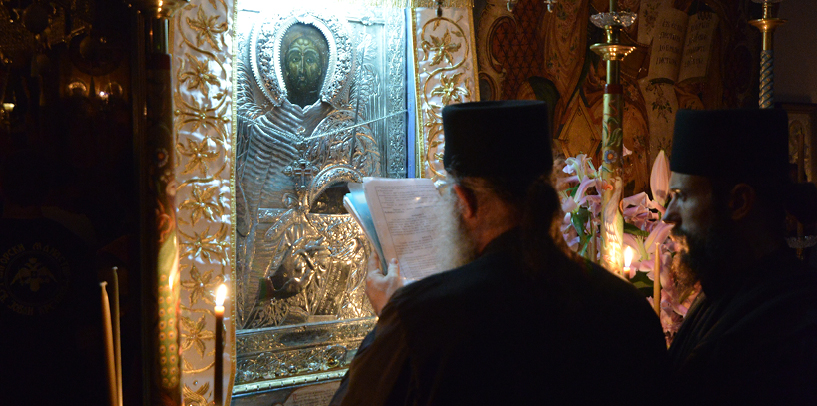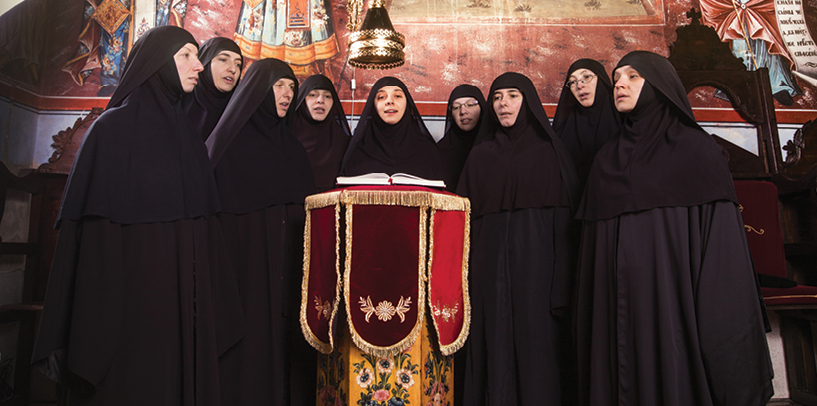The monk is a person who does not mix with the people, but continually communicates with the One God. By seeing he is seen, by loving he is loved; he becomes a light, enlightened in an unspeakable manner. When he becomes widely popular, considers himself even poorer, and while being together with the others, he still remains a stranger. Oh, a miracle, unusual as well as inexpressible. I am poor for the immeasurable wealth, and reckon I have nothing, although I have abundantly everything, I declare I am thirsty in spite of the great quantity of water.
– Saint Simeon the New Theologian
The life in the coenobitic monastery represents an icon of the angelic life in heaven. The monastics long for such a life and name themselves servants of the divine dispensation, because of the purity with which they serve the Trinitarian God. Each monk works, toils and struggles both with body and soul, and in response is given humbleness of heart. With an abundant love he serves, prays, chants, listens to the life-giving words of the psalms and feeds in the Divine Eucharist, of the immaculate Body and the precious Blood of the Incarnate Logos.
The monastic life in the Bigorski monastery is organized according to a Typicon – a daily routine schedule, that father Parthenius received as a blessing from his Elder George of the Mount Athos. So, in the prescribed time for service, the monk assigned to announce the forthcoming service, goes around the monastery and hits the semantron three times in an interval of fifteen minutes, and finally at 4 pm, the sound of the bell announces the beginning of the Vespers. Thus the ninth hour service begins, when Lord Jesus Christ tasted death and when the robber did what he knew best –stole heaven, with the words: “Remember me Lord…” and was the first to inhabit the Kingdom of Heaven. First, the monks venerate the holy icons and then take their seats on the narrow and long wooden chairs, the stasidia, which as if open tombs, accept those that have chosen the life of crucifixion. Soon after that one can hear the lines of the Psalm about the origins of the world, which denotes the beginning of the Vespers service.
“Lord, I have summoned unto Thee. Hearken me oh Lord!, it resounds painfully, as if the repenting weep of Adam before the Paradise lost. The prayers arising from the hearts of the monks, of the pilgrims and the faithful, blend with the chanting of the choir, pleading for help from the merciful hand of God, the Mother of God, the Angels and the saints, who are intercessors to those that fight spiritually.
After the common service, the monks get together in the Refectory, which very much resembles a church because of the frescoes on its walls. The central position at the table is taken by the Abbot, and after him are the seats of the hieromonks, each according to their order. The meal (lunch and supper), although somewhat formal, is humble. The monks in the cenobitic monastery never eat meat, while in the fasting days – Monday, Wednesday and Friday, they fast without oil. During the meal, there is a complete silence in the dining room. Only the voice of the monk can be heard, reading the life of saints for that particular day or some other educational text by the ancient or the new Fathers of the Church.
The day ends with a small Compline, when the Akathist hymn before the icon of the Mother of God is read. In the twilight of the church only the lit candles can be seen and the joyous exclamation of the reader is heard: “Rejoice Bride Unwedded!”. This service puts an end to the passing day, ending with a veneration of the icons and the last blessing from the Abbot. Then, while the sun hastes to the west, the monks haste to their cells to give account before God about their thoughts and deeds and to cleanse through tears all the traces that sin left in their hearts throughout the departing day.
After spending the night in contemplation about God and prayer, the monks greet the new day with the troparion: “Rising from sleep, we praise Thee oh Good and we sing an angelic song to Thee: Holy, Holy, Holy Thou art Lord, through the prayers of Theotokos have mercy on us!”
It is five in the morning and the morning semantron summons the monks to church. It is time for: “Glory to the Holy One-Living, Life-giving and Undivided Trinity “ – the beginning of the reading of the six Psalms. These are the holiest moments of the Morning service. This is the time of the righteous Judgment and blessed are those that possess the light of virtues, for they shall abide in the unending light. “God is Lord and showed Himself to us. Blessed is he who comes in the name of Lord”. Readings, psalms, troparia and canons dedicated to the saints of the day, those that with their faith and love devoted their lives to Him, Who is Himself the Life and Love – Lord Jesus.
The service ends with a Divine Liturgy, which is the crown of the daily and the nocturnal prayers. It seems to pour humbleness, through the soft and prayerful voices of the psalts and the priests. Through the Holy Chalice, the Lord invites everyone to partake in His Mystical Supper, but He also warns: “Cleanse your hearts through repentance, confess your sins before the Ruler”. Only those that approach the Body and Blood of Christ with cleansed conscience are capable of acquiring life in Christ.
Time at the Bigorski monastery passes quickly. It is a true miracle how the nights substitute the days and the week comes to an end. When monasticism is properly lived, then it is a life that outreaches the natural laws, it is a true martyrdom. Therefore God, Who exists eternally, for this temporary and short-lasting martyrdom grants the monks hope for eternity and resurrection. Every monk lives for the resurrection. That is why Easter is the holiest and the most joyful feast in the monastery, when all and every one breathe with Christ’s Resurrection, as is chanted in the Paschal service: “Pascha, Lord’s Pasha and again I shall say, Pascha, for the glory of the Holy Trinity, transition from darkness to light, Pascha, delivering from the hades. Pascha ascension from earth to heaven. Pascha, transition from death to life. Pascha, a true life for the faithful. It is a rest for the soul, light for the eyes, softness of speech, it is exaltation, joy, peace…”
Day and night, in their life, monks distance from earthly things and approach what is heavenly. It is a miraculous way of offering. Despite the numerous worldly worries, that intrude into the monastic living like traps, it is a life directed towards subtler spiritual goals. Poverty, cleanliness and obedience are the unchanged aims of each monk striving to acquire them through prayer, work and fasting.
Work is inseparable part in the life of every monk from the Bigorski monastery. Some work in the fields, some in the garden, some in the kitchen, some on the building site… Whatever their obedience, the monks unceasingly call Christ the Bridegroom silently uttering: “Lord Jesus Christ, have mercy on me!”
While prayer unceasingly flows, the entire nature around the monastery of the Forerunner, with the tall maple and chestnut trees, like signposts to heaven, together with the fountains, the forest and the river whisper: “Hallelujah…” And as always and forever, from the dome of the monastery church peeking from the green, the Pantocrator does not stop blessing and giving rest to the living and to the dead and keeps providing consolation and hope to all of human race.


















